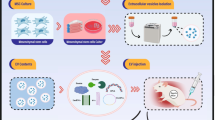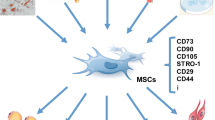Abstract
Umbilical cord blood mesenchymal stem cells (UCB-MSCs) have been shown to be a source of stem cells for use in cellular therapies and have immunomodulatory effects on several immune cells in an inflammatory environment. However, whether UCB-MSCs have immunomodulatory effects against lipopolysaccharide (LPS)-induced inflammatory cytokine secretion in macrophages and whether it is involved in phosphoinositide 3-kinase/protein kinase B (PI3K/Akt) signaling pathway remain unclear. After co-culture of UCB-MSCs and phorbol 12-myristate 13-acetate (PMA)-activated human THP-1 cells using a transwell system, it showed that LPS significantly induced increases in the expression levels of interleukin 10 (IL-10), interleukin 37 (IL-37), phospho-PI3K (p-PI3K), and phospho-Akt (p-Akt) in macrophages. UCB-MSCs upregulated the expression of IL-10, IL-37, p-PI3K, and p-Akt, while it had no obvious effect on PI3K and Akt levels. Inhibitors of PI3K (LY294002) significantly suppressed the expression of IL-10, IL-37, p-PI3K, and p-Akt; however, it had no effect on the expression levels of PI3K and Akt. The present study demonstrated that UCB-MSCs increased the LPS-stimulated expression of IL-10 and IL-37 in macrophages through the PI3K/Akt signaling pathway.



Similar content being viewed by others
Abbreviations
- UCB-MSCs:
-
Umbilical cord blood mesenchymal stem cells
- PI3K/Akt:
-
Hosphoinositide 3-kinase/protein kinase B
- LPS:
-
Lipopolysaccharide
- IL-10:
-
Interleukin 10
- IL-37:
-
Interleukin 37
- PMA:
-
Phorbol 12-myristate 13-acetate
References
Singer, M., C.S. Deutschman, C.W. Seymour, M. Shankar-Hari, D. Annane, M. Bauer, R. Bellomo, et al. 2016. The third international consensus definitions for sepsis and septic shock (Sepsis-3). Jama 315 (8): 801–810. https://doi.org/10.1001/jama.2016.0287.
Pan, B., X. Wang, S. Kojima, C. Nishioka, A. Yokoyama, G. Honda, K. Xu, and T. Ikezoe. 2017. The fifth epidermal growth factor like region of thrombomodulin alleviates LPS-induced sepsis through interacting with GPR15. Thrombosis and Haemostasis 117 (3): 570–579. https://doi.org/10.1160/th16-10-0762.
Seeley, J.J., R.G. Baker, G. Mohamed, T. Bruns, M.S. Hayden, S.D. Deshmukh, D.E. Freedberg, and S. Ghosh. 2018. Induction of innate immune memory via microRNA targeting of chromatin remodelling factors. Nature 559 (7712): 114–119. https://doi.org/10.1038/s41586-018-0253-5.
Ito, S., Y. Tanaka, R. Oshino, S. Okado, M. Hori, and K.I. Isobe. 2016. GADD34 suppresses lipopolysaccharide-induced sepsis and tissue injury through the regulation of macrophage activation. Cell Death & Disease 7: e2219. https://doi.org/10.1038/cddis.2016.116.
Libert, C., A. Ayala, M. Bauer, J.M. Cavaillon, C. Deutschman, C. Frostell, S. Knapp, et al. 2019. Part II: Minimum Quality Threshold in Preclinical Sepsis Studies (MQTiPSS) for types of infections and organ dysfunction endpoints. Shock 51 (1): 23–32. https://doi.org/10.1097/shk.0000000000001242.
Zhang, X., N. Li, H. Shao, Y. Meng, L. Wang, Q. Wu, Y. Yao, J. Li, J. Bian, Y. Zhang, and X. Deng. 2016. Methane limit LPS-induced NF-kappaB/MAPKs signal in macrophages and suppress immune response in mice by enhancing PI3K/AKT/GSK-3beta-mediated IL-10 expression. Scientific Reports 6: 29359. https://doi.org/10.1038/srep29359.
Qin, X., X. Jiang, X. Jiang, Y. Wang, Z. Miao, W. He, G. Yang, Z. Lv, Y. Yu, and Y. Zheng. 2016. Micheliolide inhibits LPS-induced inflammatory response and protects mice from LPS challenge. Scientific Reports 6: 23240. https://doi.org/10.1038/srep23240.
Chousterman, B.G., F.K. Swirski, and G.F. Weber. 2017. Cytokine storm and sepsis disease pathogenesis. Seminars in Immunopathology 39 (5): 517–528. https://doi.org/10.1007/s00281-017-0639-8.
Vilay, A. Mary, and Bruce A. Mueller. 2013. Intradialytic oral nutritional supplements improve quality of life. American Journal of Kidney Diseases 61 (2): 349–349.
Spaggiari, G.M., and L. Moretta. 2013. Cellular and molecular interactions of mesenchymal stem cells in innate immunity. Immunology and Cell Biology 91 (1): 27–31. https://doi.org/10.1038/icb.2012.62.
Wang, Y., X. Chen, W. Cao, and Y. Shi. 2014. Plasticity of mesenchymal stem cells in immunomodulation: Pathological and therapeutic implications. Nature Immunology 15 (11): 1009–1016. https://doi.org/10.1038/ni.3002.
Alma, J., Nauta, and E. Fibbe Willem. 2007. Immunomodulatory properties of mesenchymal stromal cells. Blood 110 (10): 3499–3506.
Rebelatto, C.K., A.M. Aguiar, M.P. Moretao, A.C. Senegaglia, P. Hansen, F. Barchiki, J. Oliveira, et al. 2008. Dissimilar differentiation of mesenchymal stem cells from bone marrow, umbilical cord blood, and adipose tissue. Experimental Biology and Medicine (Maywood, N.J.) 233 (7): 901–913. https://doi.org/10.3181/0712-rm-356.
Castro-Manrreza, M.E., H. Mayani, A. Monroy-Garcia, E. Flores-Figueroa, K. Chavez-Rueda, V. Legorreta-Haquet, E. Santiago-Osorio, and J.J. Montesinos. 2014. Human mesenchymal stromal cells from adult and neonatal sources: A comparative in vitro analysis of their immunosuppressive properties against T cells. Stem Cells and Development 23 (11): 1217–1232. https://doi.org/10.1089/scd.2013.0363.
Shawki, S., T. Gaafar, H. Erfan, E. El Khateeb, A. El Sheikhah, and R. El Hawary. 2015. Immunomodulatory effects of umbilical cord-derived mesenchymal stem cells. Microbiology and Immunology 59 (6): 348–356. https://doi.org/10.1111/1348-0421.12259.
Chandramoorthy, H.C., I. Bin-Jaliah, H. Karari, P. Rajagopalan, M.E. Ahmed Shariff, A. Al-Hakami, S.M. Al-Humayad, et al. 2018. MSCs ameliorates DPN induced cellular pathology via [Ca(2+) ]i homeostasis and scavenging the pro-inflammatory cytokines. Journal of Cellular Physiology 233 (2): 1330–1341. https://doi.org/10.1002/jcp.26009.
Alciato, F., P.P. Sainaghi, D. Sola, L. Castello, and G.C. Avanzi. 2010. TNF-alpha, IL-6, and IL-1 expression is inhibited by GAS6 in monocytes/macrophages. Journal of Leukocyte Biology 87 (5): 869–875. https://doi.org/10.1189/jlb.0909610.
Liu, W., L. Deng, Y. Chen, C. Sun, J. Wang, L. Zhou, H. Li, and R. Luo. 2014. Anti-inflammatory effect of IL-37b in children with allergic rhinitis. Mediators of Inflammation 2014: 746846. https://doi.org/10.1155/2014/746846.
Chanput, W., J.J. Mes, and H.J. Wichers. 2014. THP-1 cell line: an in vitro cell model for immune modulation approach. International Immunopharmacology 23 (1): 37–45.
Hung, Y.L., S.H. Fang, S.C. Wang, W.C. Cheng, P.L. Liu, C.C. Su, C.S. Chen, M.Y. Huang, K.F. Hua, K.H. Shen, Y.T. Wang, K. Suzuki, and C.Y. Li. 2017. Corylin protects LPS-induced sepsis and attenuates LPS-induced inflammatory response. Scientific Reports 7: 46299. https://doi.org/10.1038/srep46299.
Song, Y., H. Dou, X. Li, X. Zhao, Y. Li, D. Liu, J. Ji, F. Liu, L. Ding, Y. Ni, and Y. Hou. 2017. Exosomal miR-146a contributes to the enhanced therapeutic efficacy of interleukin-1beta-primed mesenchymal stem cells against sepsis. Stem Cells 35 (5): 1208–1221. https://doi.org/10.1002/stem.2564.
He, X., J. Shu, L. Xu, C. Lu, and A. Lu. 2012. Inhibitory effect of Astragalus polysaccharides on lipopolysaccharide-induced TNF-a and IL-1beta production in THP-1 cells. Molecules 17 (3): 3155–3164. https://doi.org/10.3390/molecules17033155.
Olafsdottir, A., G.E. Thorlacius, S. Omarsdottir, E.S. Olafsdottir, A. Vikingsson, J. Freysdottir, and I. Hardardottir. 2014. A heteroglycan from the cyanobacterium Nostoc commune modulates LPS-induced inflammatory cytokine secretion by THP-1 monocytes through phosphorylation of ERK1/2 and Akt. Phytomedicine 21 (11): 1451–1457. https://doi.org/10.1016/j.phymed.2014.04.023.
Bulau, Ana Maria, Andrea Gruschka, Rahel Schwaiger, Charles A. Dinarello, and Philip Bufler. 2013. 30: Anti-IL-37 antibody abrogates the protection in IL-37 transgenic mice to LPS-induced septic shock. Cytokine 63 (3): 250–250.
Yang, Zi Jin, Jia Li Guo, Si Guang Lu, Chang Long Gao, Hong Mei Li, and Yue Feng. 2016. Human umbilical blood cord mesenchymal stem cell transplantation combined with injection of ganglioside for cerebral palsy. Chinese Journal of Tissue Engineering Research 20 (19): 2803-2809. https://doi.org/10.3969/j.issn.2095-4344.2016.19.010.
Maeß, Marten B., Berith Wittig, Andrea Cignarella, and Stefan Lorkowski. 2014. Reduced PMA enhances the responsiveness of transfected THP-1 macrophages to polarizing stimuli. Journal of Immunological Methods 402 (1–2): 76–81.
Walter, James, Lorraine B. Ware, and Michael A. Matthay. 2014. Mesenchymal stem cells: Mechanisms of potential therapeutic benefit in ARDS and sepsis. The Lancet Respiratory Medicine 2 (12): 1016–1026.
Matthay, M.A., S. Pati, and J.W. Lee. 2017. Concise review: Mesenchymal stem (stromal) cells: Biology and preclinical evidence for therapeutic potential for organ dysfunction following trauma or sepsis. Stem Cells 35 (2): 316–324.
Schulte, W., J. Bernhagen, and R. Bucala. 2013. Cytokines in sepsis: Potent immunoregulators and potential therapeutic targets--an updated view. Mediators of Inflammation 2013,(2013-6-18) (7): 165974.
Cook, D.N., D.S. Pisetsky, and D.A. Schwartz. 2004. Toll-like receptors in the pathogenesis of human disease. Nature Immunology 5 (10): 975–979.
Lee, Chunghyun, Hyun Jung An, Jung Ln Kim, Hayyoung Lee, and Sang Gi Paik. 2009. Inhibitory effect of a phosphatidyl ethanolamine derivative on LPS-induced sepsis. Molecules and Cells 27 (2): 251–255.
Jamal Uddin, M., Y. Joe, S.K. Kim, S.Oh. Jeong, S.W. Ryter, H.O. Pae, and H.T. Chung. 2016. IRG1 induced by heme oxygenase-1/carbon monoxide inhibits LPS-mediated sepsis and pro-inflammatory cytokine production. Cellular & Molecular Immunology 13 (2): 170–179. https://doi.org/10.1038/cmi.2015.02.
Pedrazza, L., M. Cubillos-Rojas, F.C. de Mesquita, C. Luft, A.A. Cunha, J.L. Rosa, and J.R. de Oliveira. 2017. Mesenchymal stem cells decrease lung inflammation during sepsis, acting through inhibition of the MAPK pathway. Stem Cell Research & Therapy 8 (1): 289. https://doi.org/10.1186/s13287-017-0734-8.
Auwerx, J. 1991. The human leukemia cell line, THP-1: A multifacetted model for the study of monocyte-macrophage differentiation. Experientia 47 (1): 22–31.
He, Xiaojuan, Jun Shu, Li Xu, Cheng Lu, and Aiping Lu. 2012. Inhibitory effect of Astragalus polysaccharides on lipopolysaccharide-induced TNF-a and IL-1β production in THP-1 cells. Molecules 17 (3): 3155–3164.
Zhang, Diya, Lili Chen, Shenglai Li, Zhiyuan Gu, and Jie Yan. 2008. Lipopolysaccharide (LPS) of Porphyromonas gingivalis induces IL-1beta, TNF-alpha and IL-6 production by THP-1 cells in a way different from that of Escherichia coli LPS. Innate Immunity 14 (2): 99–107.
Diana, Boraschi, Lucchesi Davide, Hainzl Stefan, Leitner Maria, Maier Elisabeth, Mangelberger Doris, J. Oostingh Gertie, Pfaller Tobias, Pixner Claudia, and Posselt Gernot. 2011. IL-37: A new anti-inflammatory cytokine of the IL-1 family. European Cytokine Network 22 (3): 127–147.
Nold, Marcel F., Claudia A. Noldpetry, Jarod A. Zepp, Brent E. Palmer, Philip Bufler, and Charles A. Dinarello. 2010. IL-37 is a fundamental inhibitor of innate immunity. Nature Immunology 11 (11): 1014–1022.
Nemeth, K., A. Leelahavanichkul, P.S. Yuen, B. Mayer, A. Parmelee, K. Doi, P.G. Robey, et al. 2009. Bone marrow stromal cells attenuate sepsis via prostaglandin E(2)-dependent reprogramming of host macrophages to increase their interleukin-10 production. Nature Medicine 15 (1): 42–49. https://doi.org/10.1038/nm.1905.
Gonzalez-Rey, E., P. Anderson, M.A. Gonzalez, L. Rico, D. Buscher, and M. Delgado. 2009. Human adult stem cells derived from adipose tissue protect against experimental colitis and sepsis. Gut 58 (7): 929–939. https://doi.org/10.1136/gut.2008.168534.
Pedrazza, L., A. Lunardelli, C. Luft, C.U. Cruz, F.C. de Mesquita, S. Bitencourt, F.B. Nunes, and J.R. de Oliveira. 2014. Mesenchymal stem cells decrease splenocytes apoptosis in a sepsis experimental model. Inflammation Research 63 (9): 719–728. https://doi.org/10.1007/s00011-014-0745-1.
Zhao, X., D. Liu, W. Gong, G. Zhao, L. Liu, L. Yang, and Y. Hou. 2014. The toll-like receptor 3 ligand, poly(I:C), improves immunosuppressive function and therapeutic effect of mesenchymal stem cells on sepsis via inhibiting MiR-143. Stem Cells 32 (2): 521–533. https://doi.org/10.1002/stem.1543.
Guha, M., and N. Mackman. 2002. The phosphatidylinositol 3-kinase-Akt pathway limits lipopolysaccharide activation of signaling pathways and expression of inflammatory mediators in human monocytic cells. The Journal of Biological Chemistry 277 (35): 32124–32132. https://doi.org/10.1074/jbc.M203298200.
Ehrhardt, C., and S. Ludwig. 2009. A new player in a deadly game: Influenza viruses and the PI3K/Akt signalling pathway. Cellular Microbiology 11 (6): 863–871. https://doi.org/10.1111/j.1462-5822.2009.01309.x.
Xie, Z.F., G. Xin, Y.X. Xu, Y. Su, and K.S. Li. 2016. LPS-primed release of HMGB-1 from cortical astrocytes is modulated through PI3K/AKT pathway. Cellular and Molecular Neurobiology 36 (1): 93–102. https://doi.org/10.1007/s10571-015-0223-5.
Chen, G., J. Zhao, Y. Yin, B. Wang, Q. Liu, P. Li, L. Zhao, and H. Zhou. 2014. C-type natriuretic peptide attenuates LPS-induced endothelial activation: Involvement of p38, Akt, and NF-kappaB pathways. Amino Acids 46 (12): 2653–2663. https://doi.org/10.1007/s00726-014-1816-x.
Gharbi, S.I., M.J. Zvelebil, S.J. Shuttleworth, T. Hancox, N. Saghir, J.F. Timms, and M.D. Waterfield. 2007. Exploring the specificity of the PI3K family inhibitor LY294002. The Biochemical Journal 404 (1): 15–21. https://doi.org/10.1042/bj20061489.
Acknowledgments
We would like to thank Jin Yang, Wenxue Liang, Yongjuan Liu, Juan Huo, and Ting Zhang for technical assistance and thank Boya Life Stem Cell Technology and the Key Laboratory of Systematic Bioengineering, Ministry of Education, Tianjin University for the provided support.
Funding
This study was supported by The National Natural Science Foundation of China (Grant No. 81300052), the Jiangsu Provincial Commission of Health and Family Planning (Grant No. H201558), and Postdoctoral Research Foundation of China (Grant No. 2015 M570420).
Author information
Authors and Affiliations
Corresponding authors
Ethics declarations
Conflict of Interest
The authors declare that they have no conflict of interest.
Additional information
Publisher’s Note
Springer Nature remains neutral with regard to jurisdictional claims in published maps and institutional affiliations.
Rights and permissions
About this article
Cite this article
Zhou, T., Sun, Y., Wang, Y. et al. Umbilical Cord Blood Mesenchymal Stem Cells Enhance Lipopolysaccharide-Induced IL-10 and IL-37 Production in THP-1 Cells. Inflammation 42, 987–993 (2019). https://doi.org/10.1007/s10753-019-00960-z
Published:
Issue Date:
DOI: https://doi.org/10.1007/s10753-019-00960-z




